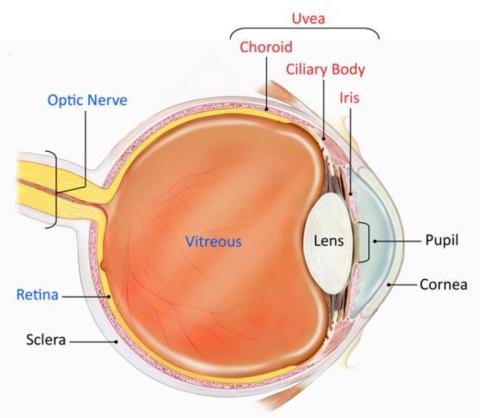Coalition Sheds Light on Inflammatory Eye Disease

Photo: NEI
An international coalition of eye researchers used machine learning to classify 25 of the most common types of uveitis, a collection of more than 30 diseases characterized by inflammation inside the eye. Together, these diseases are the fifth leading cause of blindness in the U.S.
The standardization of uveitis nomenclature (SUN) working group, funded by NEI, published its classification criteria in the American Journal of Ophthalmology.
In uveitis, inflammation can be seen in the anterior chamber (anterior uveitis), vitreous (intermediate uveitis), choroid, or retina (posterior uveitis), or all of these (panuveitis).
Disease course, complications of uveitis, and the effect on vision vary dependent on the specific disease. Some uveitis appears abruptly and resolves. But many cases are recurrent or chronic, requiring long-term therapy. Symptoms may include floaters, vision loss, pain and light sensitivity. Uveitis can strike at any age and dramatically affect quality of life.
Until recently, classification of uveitis was based on the primary location of inflammation. However, types of uveitis affecting the same anatomic location can have different causes, courses, prognoses and treatment needs. Previous work by SUN demonstrated that even uveitis experts can disagree on diagnosis, making comparisons difficult when conducting clinical research.
SUN, a team of nearly 100 international uveitis experts from more than 20 countries and 60 clinical centers, worked together throughout the project that involved informatics, consensus techniques and technology to help identify important characteristics that distinguished each disease.
The team entered 5,766 cases into a database, averaging 100-250 of each uveitis type. Only cases with a more than 75 percent agreement among experts were included in the final database. The resulting cases (4,046) were put through machine learning to create training and validation sets.
“These classification criteria are a major step forward for epidemiological studies, translational studies, pathogenesis research, outcomes research and clinical trials, said Dr. Douglas Jabs, SUN project leader and professor of epidemiology and ophthalmology, Johns Hopkins Bloomberg School of Public Health. “They hopefully will yield better disease-specific approaches to diagnosis and treatment.”
